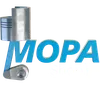TEMPERATURE GAUGE Displays for Diesel and Marine Engines
Display components are the operator’s window into what an engine is doing. In propulsion rooms, engine rooms, genset panels, or control consoles, the Display category covers instruments that visualize vital parameters at a glance—most importantly a TEMPERATURE GAUGE for coolant, lube oil, cylinder head, charge air, or exhaust gas. These displays translate sensor signals into readable values, enabling crews and technicians to react before stress or thermal overload affects the engine. In short: without a reliable, readable TEMPERATURE GAUGE display, safe operation and efficient performance are at risk.
How a TEMPERATURE GAUGE Display Works in a Marine Engine or Diesel Engine
A TEMPERATURE GAUGE display sits between the engine’s temperature sender and the operator. Depending on the application, the sender may be resistive (e.g., 10–180 Ω or 240–33 Ω curves), RTD (PT100/PT1000), thermistor (NTC), or a thermocouple. In many modern systems, the signal is also available digitally via CAN J1939 or NMEA 2000. The display’s internal electronics linearize, filter, and calibrate the input so that the pointer or digital readout reflects true temperature under vibration, voltage variations, and ambient changes.
Analog gauges typically use a damped stepper motor or bimetal movement for smooth, readable motion. Digital variants integrate a microcontroller that performs signal conditioning, averaging, and alarm logic, often with configurable thresholds for pre-alarm and shutdown. Marine versions are built with high-contrast dials, anti-fog lenses, sealed bezels, and IP-rated fronts for humidity and spray. In heavy-duty diesel engine environments, the display must tolerate shock, vibration, and electrical noise while maintaining stable indication.
On a bridge console or engine panel, one TEMPERATURE GAUGE may be dedicated to jacket water, while others monitor charge-air coolers, bearing temperatures, or EGT per bank. When paired with TEMPERATURE GAUGE OEM parts such as matched senders and harnesses, the system achieves tight accuracy and repeatability across the engine’s load range.
· Key characteristics and advantages of Display components for TEMPERATURE GAUGE applications:
· Clear, high-contrast readout for quick decisions under pressure.
· Accurate scaling matched to the sender curve or protocol.
· Fast response with damping to prevent needle flutter.
· Robust build: shock, vibration, and salt‑mist resistance.
· IP-rated fronts and anti-fog lenses for marine use.
· Alarm outputs for bridge, PLC, or safety systems.
· Compatibility with CAN J1939/NMEA 2000 and analog inputs.
· 12/24 V DC operation and low power draw.
· Easy panel integration with standard cutouts and bezels.
· Traceable part numbers for confident maintenance planning.
Why the TEMPERATURE GAUGE Display is Critical for Engine Reliability
Thermal control underpins engine reliability and service life. If a TEMPERATURE GAUGE display is unclear, inaccurate, or intermittently failing, crews may miss the early signs of overheating or insufficient warm-up. The consequences are well known: oil film breakdown, liner scuffing, head gasket leakage, turbocharger distress, and coolant cavitation in pumps and jackets. Even small indication errors can mask slow-rising temperatures caused by fouled coolers, air locks, or failing thermostats.
Wear in a display can show up as pointer sticking, dim backlights, condensation under the lens, corroded terminals, or drifted calibration. In digital displays, software faults or poor EMC immunity may cause sporadic blanks or frozen values. Any of these conditions increases the risk of operating outside safe limits, unplanned downtime, or false trips that disrupt schedules. Keeping the TEMPERATURE GAUGE display in top condition is therefore both a safety requirement and a cost-control strategy for fleet operators and power plant owners.
Advantages of OEM Spare Parts Suitable for TEMPERATURE GAUGE Displays
Specifying OEM spare parts suitable for the Display category ensures the TEMPERATURE GAUGE operates exactly as engineered. These parts are built to the correct electrical curves, signal ranges, and mechanical interfaces, which prevents misreads that often occur with mismatched components.
Benefits include precise calibration across the full temperature span, consistent color and scale for crews accustomed to specific dials, and proven compatibility with existing senders, harnessing, and control modules. With OEM spare parts, the mounting hardware, bezels, and connector pinouts align with the panel, minimizing refit time and reducing the chance of wiring errors. The result is stable indication, dependable alarm behavior, and predictable service intervals that protect both performance and budget over the engine’s lifecycle.
MOPA — Your Partner for OEM TEMPERATURE GAUGE Display Solutions
MOPA supplies OEM parts for diesel and gas engines with a focus on speed, quality, and security in every transaction. For TEMPERATURE GAUGE displays in marine engine and power-generation environments, MOPA supports precise part identification, cross-references, and technical validation against engine models and serials. That means you get the right display, matched to the correct sender curve or CAN message set, delivered quickly and with full traceability.
From single instruments to complete panel sets, MOPA streamlines procurement with documented quality, tested components, and global logistics. Our team helps you select the correct measurement range, bezel type, IP rating, illumination, and alarm options so the display integrates seamlessly into existing bridge or MCC layouts.
Selection Notes for a TEMPERATURE GAUGE Display
When choosing a display, confirm the sensor technology (resistive, RTD, thermocouple, or CAN), the measurement range needed for coolant, oil, or EGT, and the supply voltage (12/24 V DC). Check ingress protection for marine engine rooms, vibration class, EMC ratings, and the mechanical fit: panel cutout, mounting depth, and bezel style. Align alarm setpoints with engine protection logic and verify compatibility with your PLC, governor, or safety system.
Conclusion: TEMPERATURE GAUGE Display and OEM Spare Parts
A precise, durable TEMPERATURE GAUGE display is essential to protect engines, optimize performance, and support confident decision-making on board and on site. Choosing OEM spare parts suitable for the Display category preserves accuracy, fit, and long-term reliability—saving time and cost while safeguarding critical assets.


